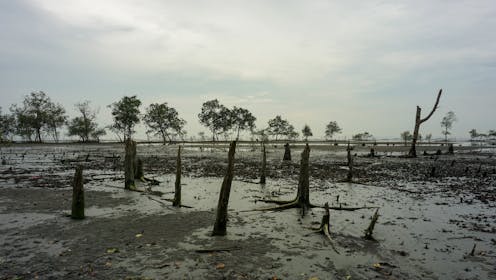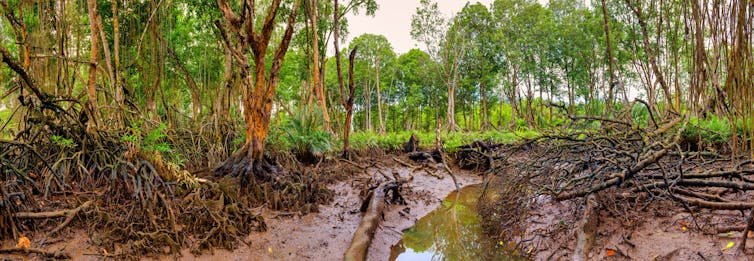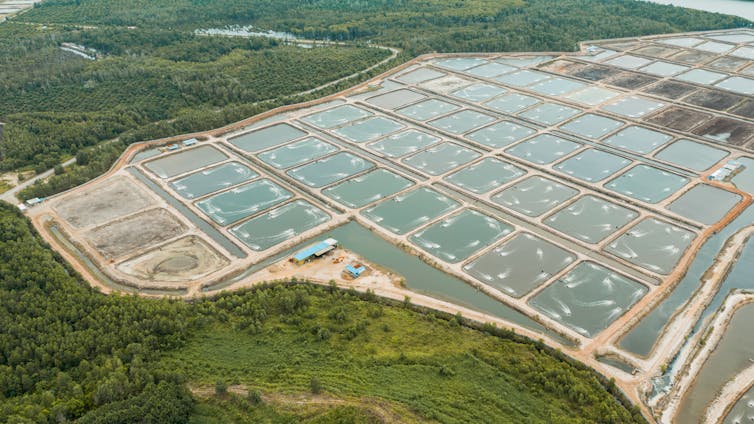
Mangrove forests look much like the coastal cousins of inland forests, but you cannot miss their tangled prop roots that help them thrive in harsh coastal environments where the tide flows in and out and there is little oxygen in the soil. They cover much of the tropical and sub-tropical coastal belts and host a unique set of rich biodiversity. Many endangered species, such as olive ridley turtles, white breasted sea eagles and even tree climbing fish find their last refuge in these forests.
Mangroves are crucial for humans too. They are an important carbon sink and can hold up to four times more carbon per hectare than tropical rainforests. Unlike rainforests, which mostly store carbon in trunks and branches and therefore release it when the trees die, mangroves store most of the carbon in their soil and sediment. If left undisturbed, that carbon can stay put for millennia.

Mangroves also provide livelihoods for societies living near coastlines, while protecting them from violent tidal surges and floods during cyclones and hurricanes. They can also provide an economic boost through ecotourism.
Yet despite their critical importance, mangrove forests are in decline across the world. More than half of the mangroves in the Philippines have been lost since 1990. And Africa saw a net loss of 984 square kilometers between 1975 and 2013, with half of it happening in Nigeria. Around 70 different mangrove plant species are in a noticeable decline threatening the animals and human societies that depend on them.
The decline is driven by a multitude of factors ranging from shrimp farming and palm plantations to tropical cyclones and global warming. Cyclones damage mangrove forests abruptly but temporarily, so the forest can often recover. But mangroves have been struggling to deal with the more gradual and permanent damages caused by farming, fish farming and anthropogenic (human-caused) climate change.
Colleagues and I wanted to find out which factors have driven most of the decline, and whether these drivers interact to exacerbate each other’s impacts. That’s why we recently read through more than 200 scientific studies published over the past four decades, in order to synthesise the key social-ecological drivers of global mangrove deforestation. Our focus was on both natural and anthropogenic factors with their gradual and abrupt impacts as well as on their geographic coverage of impacts. We were particularly interested in how these different factors interact and amplify each other. Our results are now published in the journal Sustainability.
The lost Tokyo city
First, we wanted to summarise the patterns of decline between 1990 and 2020 and identify which species were most threatened. We found that during the past three decades 8,600 square kilometres of mangrove forests had disappeared. If those mangroves were a city, they would be larger even than Tokyo. If they were a country, they would almost cover Cyprus.
The greatest loss was in south and south east Asia, with Indonesia topping the countries. Ramsar wetland sites that contain important and rich mangrove forests have also encountered a net loss of 5% in coverage.
We identified 11 mangrove plant species that are threatened with extinction. Two of them are critically endangered: Sonneratia griffithii, found from Bangladesh to the western Malaysian Peninsula, and Bruguiera hainseii found across south east Asia whose flowers feed beautiful brown-throated and copper-throated sunbirds.

Drivers of mangroves decline
Forest clearing and pollution originating from aquaculture and agriculture are the single biggest factor, accounting for around 47% of global mangrove forest loss according to the published scientific studies we consolidated. Aquaculture and agriculture had a particularly big impact in south east Asia, west Africa and Latin America – the two critically endangered mangrove species are particular victims here.
Read more: How shrimp farming wreaked havoc on Sri Lanka's coasts

Climate change and associated sea-level rise, droughts and coastal acidity constitute the second biggest factor behind the mangrove decline. Climate change is of course global and the sea is rising everywhere, so this affected mangroves across the whole equatorial belt from north America to south east Asia.
Urbanisation and coastal development was the third major social-ecological driver we identified. We found visible deforestation caused by urbanisation in Australia, Asia and Sub-Saharan Africa.
The synergistic effect
Mangroves can thrive in harsh environments and are used to natural perturbations like tropical cyclones. But several confounding pressures exacerbating each other – known as the synergistic effect – impose much greater stress than the individual pressures alone, and that is what mangroves failed to withstand.
Our findings underline the importance of strong interactions between natural and anthropogenic factors. For example, climate change is raising the sea level and causing salt water to intrude further into mangrove forests. But prawn farming and irrigation for rice farms also means people have withdrawn more groundwater, particularly during climate change-related droughts, which in turn further increases the salt water intrusion.
The strongest interaction was found between aquaculture and agricultural activities and industrialisation and pollution. In Kenya for example, an expansion of shrimp farming has led to growth in related processing and packaging industries. Both forest clearing for shrimp farms and toxic discharges from the industries significantly shrunk the country’s mangrove forests between 2000 and 2010.
Recent major reports on climate change and global biodiversity have highlighted unique threatened ecosystems like mangroves. Globally coordinated conservation policies and raising awareness remain vital for slowing mangrove decline.
Avit K Bhowmik does not work for, consult, own shares in or receive funding from any company or organisation that would benefit from this article, and has disclosed no relevant affiliations beyond their academic appointment.
This article was originally published on The Conversation. Read the original article.







